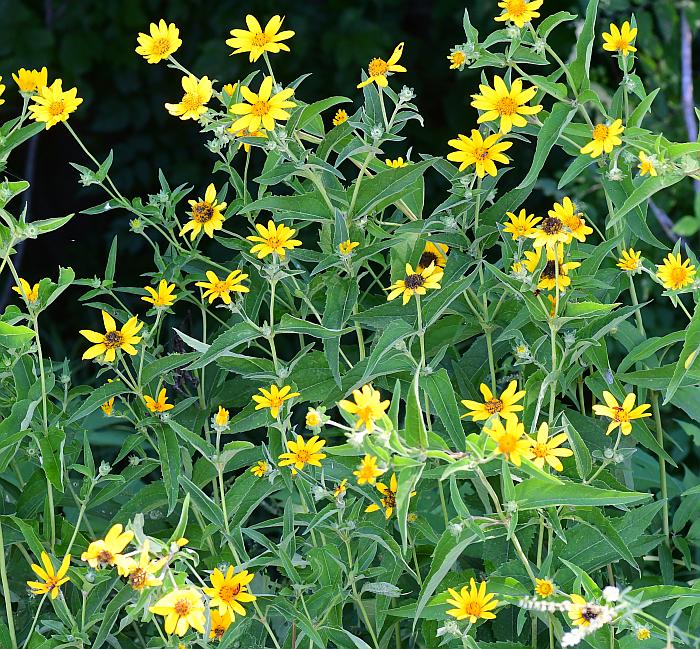Heliopsis helianthoides (L.) Sweet
Ox-Eye

Native
CC = 5
CW = 0
MOC = 82
© SRTurner
Heliopsis helianthoides (L.) SweetOx-Eye | |
 |
Native CC = 5 CW = 0 MOC = 82 |
© SRTurner |
|
Family - Asteraceae/Heliantheae Habit - Perennial forb with fibrous roots and sometimes a short, stout rhizome. Stems - Ascending to erect, to 1.5 m, usually several-branched, with fine longitudinal lines or ridges, glabrous to moderately pubescent with slender, ascending hairs or more commonly moderately roughened with short, stout, ascending, broad-based hairs. Pubescence commonly in two opposing vertical lines.
Leaves - Opposite, usually petiolate. Petiole to 3 cm long, densely antrorse pubescent. Lowermost leaves sometimes with longer petioles, the bases minutely expanded and wrapping around the stem, the petiole sometimes with sparse to moderate, long, spreading hairs. Leaf blades 3-15 cm long, oblong-lanceolate to ovate or ovate-triangular, short-tapered or angled to more or less truncate at the base, tapered to a sharply pointed tip, the margins sharply and finely to coarsely toothed and minutely hairy, the upper surface glabrous to minutely pubescent with slender, sometimes broad-based hairs or more commonly strongly roughened with short, stout, broad-based hairs, the undersurface glabrous or minutely pubescent with slender hairs or more commonly strongly roughened with short, stout, broad-based hairs, both surfaces also with scattered, sessile, spherical, yellow glands.
Inflorescences - Solitary or less commonly 2-4 heads at the branch tips and from the upper leaf axils, the heads usually with long, bractless, glabrous or roughened stalks to 20 cm. Heads - Radiate. Involucre 6-16 mm long, 10-22 mm in diameter, cup-shaped to broadly bell-shaped, the bracts 17-29, in 2 or 3 subequal series, lanceolate to ovate, rounded to sharply pointed at the tip, the outer surface usually minutely hairy or roughened, those of the outer series often somewhat longer than the others and with loosely ascending to spreading tips, green, those of the inner series slightly shorter, usually somewhat yellowish green and somewhat scalelike, more strongly ascending at the tip. Receptacle conical, elongating somewhat as the fruits mature, with chaffy bracts subtending the ray and disc florets, these 8.0-8.5 mm long, oblong-lanceolate, concave and wrapped around the florets.
Flowers - Ray florets 8-16, pistillate (with a 2-branched style exserted from the short tube at flowering), the corolla 15-40 mm long, relatively broad, pale yellow to orangish yellow, glabrous or nearly so, persistent and turning papery at fruiting. Disc florets 10-80, perfect, the corolla 4-5 mm long, greenish yellow to brownish yellow, glabrous, not expanded at the base or persistent at fruiting. Style branches with the sterile tip somewhat elongate and tapered. Pappus of the ray and disc florets absent or the disc florets with 2-4 minute teeth.
Fruits - Achenes 3.0-3.5 mm long, narrowly rectangular to slightly wedge-shaped in outline, strongly 3-angled (ray florets) or 4-angled (disc florets), the surface usually appearing finely pebbled, glabrous, dark brown to black, somewhat shiny.
Flowering - May - October. Habitat - Upland forests, savannas, glades, prairies, sand prairies, streambanks, seeps, bluffs, fields, pastures, fencerows, railroads, roadsides. Also commonly cultivated. Origin - Native to the U.S. Lookalikes - Several species of Helianthus; more broadly, many other yellow composites. Other info. - This species is found throughout Missouri and across much of the central U.S. It can be identified by its opposite, roughly toothed leaves and flowering heads with fertile ray florets. The color of the ray florets is somewhat more orange than the florets of sunflowers (Helianthus sp.), and with some practice this difference can be ascertained visually in the field. Also, the protruding styles at the base of the ray florets, which show them to be fertile, are never found on the ray florets of Helianthus Note that late in the season the styles may dry up and wilt, becoming very difficult to see. Photographs taken at Logan Creek, Reynolds County, MO., 5-23-03 and 7-6-03 (DETenaglia); also at Shaw Nature Reserve, Franklin County, MO, 6-22-2007, and along the Katy Trail near Dutzow, Warren County, MO, 8-16-2020 and 7-12-2022 (SRTurner). |